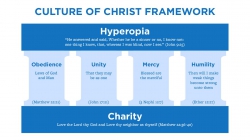Discovering the Culture of Christ
PROVO, Utah – Feb 26, 2021 – Geert Hofstede, a Dutch social psychologist, defined culture as “the collective programming of the mind that distinguishes the members of one group or category of people from others.” This is one of the definitions Simon Greathead, professor at the BYU Marriott School of Business, uses to describe something he calls the Culture of Christ Framework. But, unlike frameworks developed by researchers such as Hofstede, the Culture of Christ Framework was developed by Greathead and his MSB 432 International Business Culture class.
The idea of developing the Culture of Christ Framework came to Greathead while he was listening to the October 2020 general conference of The Church of Jesus Christ of Latter-day Saints. While listening, he noticed specific themes that were reminiscent of topics he was preparing to teach in class, including unity, loving your enemy, sustainable society, and culture of Christ. These themes would later be used to create a framework—something often used as a structure to teach and map concepts or ideas. Later that week, when Greathead invited his students to discuss what they had learned from general conference, the students’ insights related closely with Greathead’s thoughts on the creation of a framework.
Because of the class engagement and the subject’s relevance to what he was teaching, Greathead felt that the talks given in general conference contained important topics that he and his students could spend more time studying. “If I were to define the culture of Christ, or the lens through which Christ saw the world, what would that lens look like?” he wondered.
The next time he and his class met together, Greathead split his students into groups, assigning October 2020 general conference talks for each to take home and read. The following class period, his students shared and combined their insights to create a model of the framework of the culture of Christ.
The framework’s foundation of charity supports four pillars: obedience, unity, mercy, and humility. “These four pillars lead us to a long-sighted, eternal perspective—hyperopia,” says Greathead, referencing the antonym of the word used in President Russell M. Nelson’s talk titled “Let God Prevail.”
But what makes this framework a cultural framework? What defines culture? Greathead says that to understand the Culture of Christ Framework, one can relate culture to a grove of trees. “Culture is like a forest, where individuals are likened to the uniqueness of an individual tree. Yet, as a whole, these trees can be defined as a forest with common characteristics—in this case, common Christlike characteristics—that can make them a community.”
Greathead’s personal application of the culture of Christ is individual to him and influences the decisions he makes. “The culture of Christ is not an external force; it’s something that I choose to be because I know the expression of these characteristics bears fruit,” says Greathead. “I choose to be charitable. I choose to think long-sighted.” He says that way of thinking also applies to professional life. “We need to be conscious about being a Christlike person both in business and our personal lives.”
Tanner Wegrowski, a recent 2020 global supply chain management graduate from Wildomar, California, was one of the students who participated in the Culture of Christ project. Like Greathead, he believes that cultural consciousness is important both at home and at work. “I've heard from employers that understanding culture is one of the things they’re increasingly looking for in their workforce,” he says. According to Wegrowski, that understanding can be enhanced by “becoming adept in the culture of Christ.”
Wegrowski wasn’t the only student who benefitted from the Culture of Christ project. Finance major Emmie Schow, a senior from Boise, Idaho, says that she enjoyed the engagement the project provided. “Professor Greathead did a great job of listening to everyone’s input,” she says. “I enjoyed seeing the different models everyone created and then seeing how Professor Greathead took different elements from each one to create the framework.”
By listening to her classmates’ ideas and contributing to the Culture of Christ Framework, Schow learned to think about Jesus Christ in a new way. “Before this class, I hadn’t thought about Christ being a cultural model and example,” she says. “That idea was eye-opening to me.”
Though Greathead may not require his students to recreate the Culture of Christ Framework for class every semester, he does plan on incorporating discussion about the framework’s meaning and application into the class’s curriculum. “There’s more development to be done and more story to be told about this particular framework—that’s what I would like to pursue in the classroom; that will be the story for future students to tell.”
Media Contact: Chad Little (801) 422-1512
Writer: Rebecca Nissen





